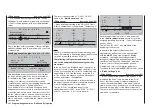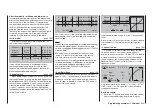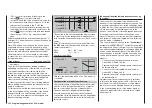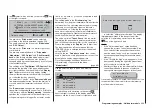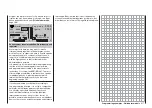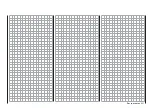
313
Programming examples - Helicopter models
Pitch
Curve
off
Point
Output
Input
0%
0%
1
+
–
100
¼
O U
T P U
T
1
0%
Normal
Always try to make due with these three points
initially; more points can "over-complicate" the matter
and are more of a burden at this point.
The reference point for the hovering should generally
be the mechanical center position of the pitch joystick,
because this position comes closest to the normal
control feel. Although the curve adjustment enables
other settings, you must know exactly what you
are doing. First set the pitch joystick in the center.
The servos which you had previously set according
to manufacturer specifi cations have their levers at
positioned perpendicularly to the servo housing
(normally). A hovering pitch value of 4° to 5° is now
mechanically set at the control rods to the rotor blades.
In principle, all known helicopters fl y with this setting.
Then move the pitch joystick towards maximum pitch
until the limit position. (The vertical line shows you
the current joystick position.) Now change the pitch
curve's point "H" with the selection keys of the right
touch pad such that the main rotor's blades have a
maximum pitch of about 9°. A value of +50 % should
be about right.
Pitch
Curve
off
Point
Output
Input
+100%
+50%
1
+
–
100
¼
O U
T P U
T
1
+50%
Normal
Note:
A rotor blade adjustment gage, such as the Graupner
pitch gage, order no.
61
, is quite useful for reading
the angle.
Now move the pitch joystick toward the pitch
minimum position until its limit position. Depending
on the ability of the pilot, adjust the value of point "L"
so that the blade angle of approach is 0 to -4°. Now a
slightly pitched line arises at the hovering points, the
so-called pitch curve, which can appear as follows:
Pitch
Curve
off
Point
Output
Input
–100%
–75%
1
+
–
100
¼
O U
T P U
T
1
–75%
Normal
Now you can, if you like, move the marker frame
upward with the selection keys to the "Curve" line
and after activation of the value fi eld with a brief tap
on the center
SET
key of the right touch pad, set the
curve function of the mixer to "on".
Pitch
Curve
Point
Output
Input
–100%
–75%
1
+
–
100
¼
O U
T P U
T
1
–75%
Normal
on
If you now switch to autorotation phase – at the
bottom left of the display the fl ight phase name
"Autorot" appears – the "old" pitch curve is again:
Pitch
Curve
off
Point
Output
Input
–50%
–50%
?
+
–
100
¼
O U
T P U
T
1
0%
Autorot
Now carry out the same setting as before in the
normal phase. Only at point "H“ – at maximum
pitch – is it possible to increase pitch angle by about
2°. In doing so, you will have somewhat more of an
angle to catch the model later on (1).
After setting pitch curve, move the autorotation
switch back then return to the helicopter mixer menu
selection with a brief tap on the center
ESC
key
of the left touch pad. In that display, change to the
"
Channel 1
¼
Throttle
" line to set the throttle curve.
The adjustment range for idle trim must fi rst be
matched to the throttle curve. Do this by putting the
pitch joystick into its minimum position then set point
"L" to about +15 %.
Channel 1
Curve
off
Point
Output
Input
0%
+15%
L
+
–
100
¼
O U
T P U
T
Throttle
Normal
+15%
With the throttle limiter
closed
and idle trim completely
open, move the pitch joystick back and forth somewhat
at the minimum limit position. The throttle servo
may not move with it in the process. No you have
established a seamless transition from the idle trim to
the throttle curve. The further settings along the throttle
curve must be carried out later in fl ight.
Summary of Contents for 32032
Page 1: ...33020 mc 20HoTT 2 en Programming Manual o Pro Pro mc 20 mc 20...
Page 15: ...15 For your notes...
Page 21: ......
Page 27: ...27 For your notes...
Page 41: ...41 For your notes...
Page 53: ...53 For your notes...
Page 59: ...59 For your notes...
Page 63: ...63 For your notes...
Page 93: ...93 For your notes...
Page 97: ...97 For your notes...
Page 141: ...141 How is a ight phase programmed...
Page 145: ...145 For your notes...
Page 155: ...155 For your notes...
Page 175: ...175 For your notes...
Page 203: ...203 For your notes...
Page 219: ...219 For your notes...
Page 253: ...253 For your notes...
Page 283: ...283 For your notes...
Page 321: ...321 For your notes...
Page 322: ...322 For your notes...
Page 323: ...323 For your notes...




